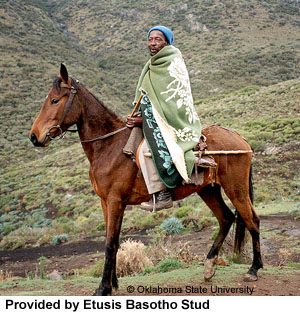
Basuto

Introduction: If you have any comments or suggestions, please click here.
Names: Basuto. I believe Basotho is another spelling. The picture above is of a Basotho pony.
Origin: The
original Cape horses of fantastic stamina and Arabian,
Barb
and Persian blood,
their beginnings going back to a handful of horses imported from Java in 1653 by
the Dutch East India Company. Later additions of English roadster blood,
and that of American-bred stallions and English Thoroughbreds, resulted in
exactly the type of animal needed by the early settlers in their great treks
inland from the Cape.
One source claimed that this was formerly known as the
Cape horse; I thought it was too small to be, but perhaps so. If so, it
would be a breed developed from the introduction of English horses into South
Africa. Much used during the Boer War, it is now on the decline as a
"pure" breed.
Breeding: Bred in South Africa, Basutoland. Like the Barb, probably goes back to the ancient Numidian breed (Equus caballus africanus). Large proportion of Oriental and Thoroughbred blood.
Description: Medium-sized pony of Oriental type with every possible structural fault, such as misplaced limbs, insufficient depth and inadequate girth, badly turned in knees and hocks, etc. (After this scathing description, from a fairly old source, but which I have no reason to disbelieve and no grounds to refute, I can only say that it apparently is an amazingly sturdy little pony for all its faults and certainly has served its purposes well!)
Action: Generally ridden at the walk, or at slow canter with plenty of rein.
Size: Approximately 13 to 14.2 hands.
Temperament: Not very imposing appearance, but very good temperament and character.
Features: Easy feeder, extremely robust constitution.
Uses: Riding pony of the Basuto, famed for its surefootedness in the mountains, and toughness.
Accomplishments: By the Boer War, Basuto ponies had been developed into fearless, sure-footed little horses that were accustomed to covering thirty or forty miles a day, moving at six miles an hour and carrying heavy equipment. On the march they were allowed to roll and graze for ten minutes in every hour. When they forbore to roll it was a signal they were too tired to be trekked further. When the reins were pulled over their heads and left on the ground, the ponies would stand unattended; a system of "ground-hitching" that added to the Boers' fire-power, by releasing the one man in four needed by the British troops for horse holding.
Curiosities:
Profiles:
Conclusion: